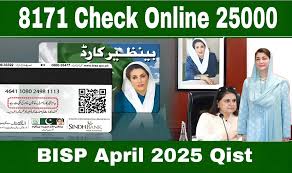The BISP 8171 program is one of Pakistan’s largest social welfare initiatives, designed to support low-income families across the country. But when it comes to understanding how many people benefit from BISP 8171 in your city, the answer depends on several factors like population size, poverty level, and the number of eligible households registered under the program. Cities like Karachi, Lahore, and Faisalabad have thousands of beneficiaries, while smaller towns receive support on a relatively modest scale. Knowing the reach of this program helps local authorities and NGOs plan better strategies for aid distribution.
According to data from various government sources, BISP 8171 beneficiaries are distributed based on a dynamic survey system that updates regularly. This ensures that only the truly deserving get enrolled in the scheme. If you’re wondering whether your area is receiving enough attention, it’s worth checking the latest local stats or visiting the BISP office in your district. Understanding the number of people who get BISP 8171 in your city not only highlights the scale of support but also reflects the socio-economic conditions of your area.

How to Check BISP 8171 Beneficiaries in Your City?
If you’re curious about how many people in your area are receiving support from the BISP 8171 program, the good news is that the process is quite simple. The government has made the system more transparent and accessible through its online portal and SMS service. You can easily check the status of BISP 8171 beneficiaries in your city by visiting the official website or contacting the local BISP office.
To check online, just enter your CNIC number on the BISP 8171 web portal, and you’ll get real-time information about your registration and payment status. While individual data is protected for privacy reasons, you can still get a general idea about the number of active beneficiaries in your region through local reports or press releases.
BISP 8171 How Many People Receive Payments in Each City?
The number of people who receive payments under the BISP 8171 program varies greatly from one city to another. Larger cities like Karachi, Lahore, and Rawalpindi have a significantly higher number of recipients due to their large populations and higher concentration of low-income families. In contrast, smaller towns and rural districts may have fewer, but still notable, beneficiaries.
The government uses data from the National Socio-Economic Registry (NSER) to ensure that the payments are reaching the most deserving. If you’re interested in knowing how many people receive BISP 8171 in your city, local BISP centers often provide updates through community boards or can be contacted directly for figures.
BISP 8171 City-Wise List of Beneficiaries
Many people search for a BISP 8171 city-wise list of beneficiaries to get an idea of how widely the program is spread across Pakistan. While complete names and personal data are not disclosed publicly, summaries and statistics are sometimes released for transparency. These lists can help you understand how actively the program is being implemented in your region.
For example, cities in Sindh and South Punjab tend to have a larger portion of families registered in the BISP 8171 scheme, especially in areas hit hard by poverty or natural disasters. If you’re wondering about your own city, keep an eye on updates from local newspapers or the BISP Facebook page, which often shares infographics and charts for public awareness.
BISP 8171 Registration Stats by City
Understanding the BISP 8171 registration stats by city gives a clear picture of how widespread the support network is. These stats are important for government planning and public accountability. Areas with higher poverty rates naturally show more registrations, especially after outreach campaigns and door-to-door surveys.
The government frequently updates these statistics, especially after new registration drives. If you’re interested in specific numbers, district commissioners and BISP regional offices usually compile data which sometimes gets published in annual reports. Knowing your city’s BISP 8171 registration figures also helps raise awareness among people who might still be eligible but haven’t applied yet.
Which Cities Have the Most BISP 8171 Recipients?
One of the most common questions people ask is: Which cities have the most BISP 8171 recipients? Unsurprisingly, urban areas with dense populations and lower average incomes dominate the list. Cities like Karachi, Hyderabad, Multan, and Quetta often lead in terms of the highest number of BISP 8171 beneficiaries.
This trend is influenced by multiple factors, including unemployment rates, education levels, and availability of social services. Government data shows that these cities receive a major share of funds allocated under BISP 8171, reflecting their higher demand for assistance. If your city ranks high, it means the government recognizes the need and is responding accordingly.
Final Thoughts
Understanding how many people get BISP 8171 in your city isn’t just about numbers—it’s about recognizing how essential this financial support is for thousands of families. The BISP 8171 program continues to be a lifeline for those struggling with rising costs of living, unemployment, and economic challenges. Whether you live in a big city like Lahore or a small town in Balochistan, the reach of this initiative reflects how deeply it’s woven into the lives of everyday Pakistanis.
As the government improves its digital systems and outreach methods, access to information about BISP 8171 beneficiaries in your city is becoming easier and more transparent. If you’re unsure whether your area is being served adequately or want to raise awareness, staying updated with local stats and registration drives is key. The more we know about the impact of BISP 8171 in our cities, the better we can ensure help reaches those who need it most.